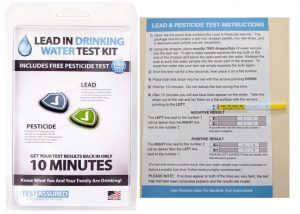It’s hard to believe that will all of the press from the Flint, Michigan water scare in 2014, we are still at risk of lead poisoning from water. Most recently, seven schools in Virginia were found to have lead in their drinking water. Ingesting lead is particularly dangerous to infants, children, pregnant and nursing mothers, and the elderly. Too often, we take for granted the quality of our water, assuming that the standards put in place to keep us safe are being followed.

What is Lead Poisoning
Lead poisoning occurs when there is a continual source of lead being ingested. Over time, the lead builds up in the body, causing serious health concerns. For people with developing and compromised immune systems, even small amounts of lead are cause for concern. Children under six years old are especially vulnerable to lead poisoning because their bodies are still developing. At very high levels, lead poisoning can be fatal.
How Does Lead Get into Water?
The Center for Disease Control (CDC) and the Environmental Protection Agency (EPA) work together to set and enforce allowable limits of lead in our water. Because public water sources are regularly tested, you may think you don’t need to worry about lead poisoning. Despite these measures, lead poisoning from water is still a risk.
Even if water tests free of lead at the source, it still must travel through an extensive system of pipes to get to your home. Along the way, it can pick up lead from older pipes, plumbing systems, and water taps. Lead can even be found in brass plumbing fixtures and copper pipes that have been soldered with lead. As water travels and sits in these pipes, lead leaches from the pipes and into the water.
Symptoms of Lead Poisoning
Lead poisoning is very hard to detect, especially at low levels. Lead is absorbed by the body and accumulates over time. Symptoms of poisoning may not appear until dangerous levels of lead have built up in the blood and organs. Sometimes even people with very high levels of lead in their blood may not show any signs of illness.
Children are very susceptible to lead poisoning because of their small size and developing bodies. Some of the symptoms you should be aware of include:
- Vomiting
- Abdominal pain
- Loss of appetite
- Weight loss
- Sluggishness and fatigue
- Irritability
- Constipation
- Seizures
- Hearing loss
- Developmental delay
- Learning difficulties
Although children are at higher risk, adults are at risk as well. Pregnant and nursing mothers should be especially cautious not to drink water contaminated with lead because some of the lead will be passed to the baby. The elderly and people in poor health should also be concerned about their water quality due to compromised immunity. Symptoms of lead poisoning in adults include:
- Joint and muscle pain
- High blood pressure
- Memory loss
- Difficulty concentrating
- Headaches
- Abdominal pain
- Mood disorders
- Reduced sperm count and abnormal sperm
- Miscarriage, stillbirth or premature birth in pregnant women
Diagnosis
If you suspect that you or someone in your family is suffering from lead poisoning, you should seek medical attention. If you live in an older home or are unsure what type of pipes were used in your home, the American Academy of Pediatrics recommends that your child be tested for lead during the first few years after birth. Screening is also recommended for older children who have never been tested.

Lead poisoning can be diagnosed through a simple blood test. Only a small sample of blood is needed, typically from a finger prick. The levels of lead are then measured in micrograms per deciliter (mcg/dL). While there are no safe levels of lead, a measurement above 5 mcg/dL indicates a potentially unsafe level for both children and adults.
Treatment
If you do test positive for lead poisoning, the first step is to identify the source of lead so exposure can be eliminated. If caught early enough, blood levels may return to normal without treatment. For severe cases, treatment is chelation therapy. This involves taking a medication that binds with the lead so that it can be excreted in urine.
Prevention
There are some simple measures you can take to prevent the risk of lead poisoning from your drinking water. If you have an older home, you should have a plumber examine your pipes to determine if they are made of lead or have lead fittings. It may be necessary to consider replacing the plumbing if it contains lead. This can be costly, but you should check with your local health department to see if there is any funding available to help offset the cost.
Another simple tip is to avoid using hot tap water for drinking, cooking, or making infant formula. Hot water should not be used for consumption because lead dissolves more easily in hot water. For drinking and cooking, be sure to run the cold water for at least a minute before using.
Test Your Water
If you want to know for sure if your water is contaminated with lead, the simplest thing to do is test it yourself. TestAssured’s Lead in Drinking Water Test Kit allows you to test for lead in water from both municipal sources and wells. The kit includes all the instructions and supplies you need to quickly test your drinking water for the presence of lead in only 10 minutes. If your tap water has lead levels exceeding 15ppb, you should take action immediately to minimize your exposure.


